Coleoptile
Coleoptile
With the term coleoptile or coleottile, in botany, we mean the membranous sheath enclosed in the embryo of the seeds of the monocotyledons which represents the first leaf of the seedling.
The coleoptile envelops the cauline bud, pierces the ground in germination and opens to let the sprout out.
The term coleoptile derives from coleo- and from the Greek πτίλον «plumetta».
Coleoptils have two vascular bundles, one on each side. Unlike cotyledonary leaflets, the pre-emergent coleoptile does not accumulate significant protochlorophylls or carotenoids, so it is generally very pale. However, in some species some pre-emerging coleoptiles accumulate purple anthocyanin pigments.
Coleoptils are made up of very similar cells and all specialized for rapid growth by elongation. They do not divide, but increase in size as they accumulate more water. Coleoptils also have vessels (often two) along the axis to provide a water supply.
When a coleoptile reaches the surface, it stops growing in favor of the cotyledon leaves.
Coleoptiles also exhibit a strong geotropic reaction, always growing upward and correcting direction after reorientation. The geotropic reaction is regulated by light (more precisely by the action of the phytochrome).

